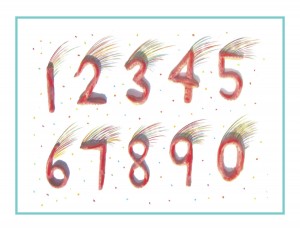Day 6
For one year, 365 days, this blog will address the Common Core Standards from the perspective of creating an alternate, ambient learning environment for math. Ambient is defined as “existing or present on all sides, an all-encompassing atmosphere.” And ambient music is defined as: “Quiet and relaxing with melodies that repeat many times.”
Why ambient? A math teaching style that’s whole and all encompassing, with themes that repeat many times through the years, is most likely to be effective and successful. Today’s blog will focus on Counting and Cardinality / Compare Numbers / Standards 6 and 7. Note that the Common Core Standards will appear in blue, followed by an ambient translation.
Counting and Cardinality K.CC
Compare Numbers
6. Identify whether the number of objects in one group is greater than, less than, or equal to the number of objects in another group, e.g., by using matching and counting standards.
7. Compare two numbers between 1 and 10 presented as written numbers.
There’s that word, “written” again. At the risk of being stuck on a concept, I need to state again that numbers and letters are abstractions. Of course, numbers and letters will be absorbed by osmosis just by your child(ren)’s being in a very print-fiendly environment. And that’s fine, but osmosis vs. drill and test are two very different strategies. And waiting for readiness to teach and learn is so very essential. So, I’m sticking to my Waldorf principles here, and offering a substitute for written numbers.
In the first grade Math By Hand system, Roman numerals are taught first, because they are so close to primitive counting with fingers. Then the Arabic numerals are formally taught, along with the story of how their forms evolved, so they become less foreign and abstract. Diving into teaching the concept that the numeral 2 is the same as ( . . ) is a stretch for a Kindergartner.
Ok then, let’s see what can be done with Standard 6. Your Kindergarten room could be stocked with many natural objects, primarily used for playing and exploring, but also as learning materials. Just to name a few: acorns, shells, small stones, sanded and smoothed branches cut into slices or chunks, and many more. Left to their own devices out in nature, every young child is a collector! These natural beauties could all be kept in baskets.
For the “equal” portion, begin by using yesterday’s number stones, taking one of them (the number 5 for instance) and casually setting it in plain view on a desk or tabletop next to 5 of the objects. No need to instruct here, since imitation is such a prevalent quality at this age. You will see that the other counting stones will be eagerly matched up with their object counterparts. All you need do is provide the venue.
For the “greater and less than” portion, introduce the formal signs for this concept: < and >, in an imaginative and pictorial way. Again, this needs little to no words. Place two of the counting stones next to each other, or use a counting stone and objects as a pair. Using your index and middle finger to form the greater-less than signs, point the open end toward the larger number and pointing to the greater stone or objects say, “bigger.” Then pointing to the lesser stone or objects say, “smaller.” Once the concept is established the terms could be changed to “greater” and “less than” but no hurry on that.
Now for Standard 7. Again using the objects and stones, have the child(ren) write a simpler version of the numbers using lines for numbers 1-4, and 4 lines with a diagonal hash line for the number 5, and two of these for the number 10. Even though the written numerals have not even been touched yet, this kind of play learning builds an incomparable foundation for the more abstract concepts to be learned later, from first grade on.
And no, your Kindergartner will not be standardized test-ready but if you’re homeschooling that’s ok. And if you’re dealing with a “test-ready” classroom, you can still supplement school lessons with these fundamental and downright nourishing activities at home, to counteract the stress that may be occurring from too-early academics.
Knowledge ensues in an environment dedicated to imaginative, creative knowing, where student and teacher alike surrender to the ensuing of that knowledge as a worthy goal. More Kindergarten tomorrow!












